Adam Yamey's Blog: YAMEY, page 168
March 10, 2021
City of relief
THERE WAS ALWAYS a tin of pink coloured Isogel granules in the bathroom of my childhood home. One of my parents took a teaspoon of this daily to ensure regularity of bowel movements. An important ingredient in Isogel is psyllium husk, which is extracted from the plants Plantago ovata and Plantago psyllium. Basically, the husk is a polysaccharide gelling agent which, believe it or not, can be used to ameliorate both constipation and diarrhoea. It might also have other health promoting properties, including possible mitigation of Type 2 diabetes, and reducing cholesterol levels in the blood.
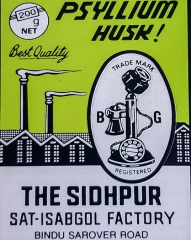
Recently, for reasons that need not be detailed here, we have taken to using psyllium husk. We did not buy Isogel, as my parents did, but a product from India called ‘Sat-Isabgol’, which my wife’s parents used in that country. This product is packed in a picturesque box that includes the company’s trademark: an old-fashioned telephone (B.G. Telephone Brand Regd.). The box we bought recently proudly proclaims that the company is in its 80th year. According to the box, Sat-Isabgol is:
“… the upper coating of Plantago Ovata (Ispagul) which is highly purified by sieving and winnowing.”
Interesting as this is, what attracted me to the box was the fact that the Sat-Isabgol factory is in Sidhur, a place we visited in Gujarat (western India).
Sidhpur is far from being a major tourist attraction, but it is not far from the ruins of the magnificent Sun Temple at Modera, which does attract many sightseers. The main attraction in Sidhpur is a couple of streets lined with mansions decorated with ornate facades and other decorative features. These were built between the 1820s and the 1930s by a successful group of Muslim traders, members of the Dawoodi Bohra sect. The buildings incorporate many features of European neo-classical styles. Many of the houses bear their owners’ monograms in Latin lettering. The streets in this rural provincial town have a surprisingly un-Indian look about them and if it were not for cows and other animals roaming about them, it might be easy to imagine that one was not in India. While I was roaming around taking pictures, local people were extremely friendly to me. I got the impression that few Europeans visit Sidhpur. One exception was at the sad ruins of a Hindu temple, the Rudra Mahalaya, where the security guards were most unenthusiastic about seeing me with a camera. I was unable to photograph it. Constructed between 943 AD and 1140 AD, this temple is was in extremely poor condition when we saw it about two years ago. If it should ever be restored, it would make Sidhpur a fine excursion for tourists staying in Ahmedabad. I liked what I saw during our brief visit to Sidhpur, but was completely unaware that the town is home to the factory which has been producing something that has brought so much relief to people all over the world, since 1940.
March 9, 2021
He lost his head but left a river
A GROUP OF AGITATED SWANS were on a stream beneath an iron bridge. A wire mesh stretched from one bank of the waterway to the other was the cause of their frustration because some of the birds were on one side of the barrier and the rest on the other, and they had not yet discovered a way to pass the obstruction. It was distressing to watch a swan on one side pecking at the mesh trying to reach the beak of another doing the same thing on its side. The purpose of the mesh was not clear to me.
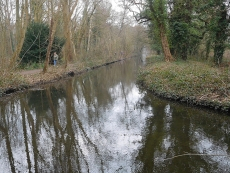
The water beneath this bridge at the northwest corner of the Waterhouse Plantation in London’s Bushy Park is flowing along the man-made Longford River. It runs from the River Colne at Longford, which is on the western edge of Heathrow Airport, to the River Thames. After being diverted into several separate channels, its waters flow into the Thames at three points near Hampton Court and Bushy Park. On reaching the northern edge of Bushy Park it flows under the bridge where I saw the frustrated swans and then through woodland until it reaches a large triangular pool, the Waterhouse Pond. From there, its waters flow through outlets controlled by sluices into a maze of streams, which water the grounds of parts of Bushy Park. The river and the Waterhouse Pond are elevated several feet above the surrounding terrain. This allows water to escape from the river via small channels and from the pond through the sluices, which have mechanical devices with taps to control the flow. Near the Waterhouse Pond there is a tall wooden totem pole, which was designed by Norman Tait and constructed in 1992. The pole was:
“Installed to mark the connection between Canada and Bushy Park, which housed a large Canadian camp during World War l.” (www.royalparks.org.uk/media-centre/fa...)
The Waterhouse Pond was a noisy place when we visited it early one morning recently. Most of the noise was being made by pairs of Canada Geese, which was rather appropriate given that they were in sight of the totem pole. The geese were craning their long necks forward and cackling loudly, their reddish tongues very visible. Nearby, occasional Egyptian Geese with their characteristic ‘eye make-up’ colouring, were furiously proclaiming something that seemed most important to them. Elsewhere in the vicinity, there was a veritable symphony of bird calls including plenty produced by green parakeets which were perched on camellia bushes, some of them pecking away at the flowers, dislodging petals one by one as they searched for something tasty. It was pleasant to be in a place that humans were completely outnumbered by birds … and squirrels.
The Longford River that supplies the water lovely features in Bushy Park did not exist prior to 1638. In that year, in accordance with the wishes of the ill-fated King Charles I, the river (really, a canal) was constructed to bring water to Hampton Court and its neighbour Bushy Park. Twelve miles in length, it took only nine months to complete. Before the twentieth century, when it acquired its present name, the waterway was known variously as: the ‘New River’, the ‘King’s River’, the ‘Queen’s River’, the ‘Cardinal’s River’, the ‘Hampton Court Cut’, and the ‘Hampton Court Canal’ (https://en.wikipedia.org/wiki/Longford_River). There is another New River in Greater London, which, like the Longford, is man-made. The other New River, which retains its original name, was built in 1613 to carry drinking water from the River Lea at Ware in Hertfordshire to reservoirs in Islington.
The part of the Longford River, which I have been describing, runs through and irrigates the Waterhouse Plantation. This and its neighbour, another plantation, the Woodland Garden, where swamp cypresses with their curious aerial outcrops may be seen, were originally planted in the early 19th century (https://historicengland.org.uk/listing/the-list/list-entry/1000281). Both areas are surrounded by fences to prevent the ingress of deer that reside in Bushy Park. They were redeveloped extensively between 1948 and 1949, and now look well-established.
After having been introduced to it by friends, who live not far away from it in Richmond, we have visited Bushy Park several times and enjoyed its variety and wildlife every time. If you are planning a visit – something I recommend highly – try to reach it early, prefer well before 10am so that you will have no difficulty parking and because at that early hour the park is reasonably empty of other visitors, many of them are dogs, which are excluded from the plantations, with their owners; joggers in expensive gear; and ‘yummy mummies’ with infants in tow or in and out of upmarket push chairs.
It was unfortunate that Charles the First lost his head, but fortunate for us that he created a waterway that makes Bushy Park so delightful today.
March 8, 2021
A quiet street in London
IT IS WONDERFUL how easy it is to escape from bustling activity on London’s main thoroughfares. Seymour Walk, a cul-de-sac leading north from London’s busy Fulham Road, is one of many such peaceful havens. In the 1860s, Seymour Walk was called ‘Seymour Terrace’. In those days it was bordered on its west side by market gardens and on its east by a line of buildings. Today, it has buildings on both sides and is entirely surrounded by land that has been built on. It is worth leaving the main road to enjoy a bit of quiet in this picturesque short street.
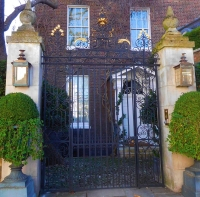
The small lane was built-up during the period between the 1790s and 1820s and is included in an area called Little Chelsea. Most of the terraces of houses along it appear to be from that era, but there are one or two newer constructions. The large house on the western side of the part of Seymour Walk nearest to Fulham Road is older than the other buildings. This larger house or a predecessor on the same spot might have existed as early as 1664 (www.british-history.ac.uk/survey-london/vol41/pp162-194#h2-0008). Its earliest occupant was a Dr John Whitaker, who lived there from 1666 to about 1670. The elegant house, number 1 Seymour Walk, as we see it today looks as if it was largely built in the 18th century. Amongst its various occupants there was one, Mary Moser (1744-1819), the Royal Academician and flower painter (). The house became a school or academy from about 1831 to 1939.
Socially, the population of Seymour Walk was very mixed during the 19th century. Its inhabitants ranged from ‘poor’ and ‘very poor’ to the ‘better off’ amongst whom were The Reverend Elias Huelin; a jeweller; an architect; a lady doctor; and various artists.
Huelin (1786-1870), who owned several properties, was murdered in one of his homes along with his house-keeper Ann Boss. It has been recorded that:
“The murders were only discovered when a box was found in the kitchen of Reverend Huelin’s unlocked house, sitting in a pool of blood. It contained the body of the housekeeper. The police then began searching for the clergyman. He was eventually found buried in the backyard of the house he had rented to Walter Millar.” (https://www.royalparks.org.uk/parks/brompton-cemetery/explore-brompton-cemetery/elias-huelin)
Huelin was murdered by Millar during a robbery, when he was living in Paulton Square in Chelsea, but still owned property in Seymour Walk.
Other buildings in Seymour Walk are pleasant aesthetically, but not notable architecturally or from a historical point of view. A curve near the beginning of the Walk effectively insulates most of it from the busy thoroughfare into which it leads. It was only because the road looked so attractive from Fulham Road that I decided to wander along it. It is small peaceful enclaves such as Seymour Walk that help to make London a pleasant city to live in and visit.
March 7, 2021
A grand old house in north London
THE OLD WELLS AND CAMPDEN Wash Houses stand on an elevated section of Hampstead’s Flask Walk and overlook a distinguished-looking detached house standing in its grounds surrounded by walls at the eastern end of Flask Walk. Entered through an unusual double set of wrought iron gates, this is Gardnor House, which was built in 1736. The doubling of the gates has happened since the 1960s, during which time it was a single gate (see image at: https://images.historicenglandservices.org.uk/historic-images/1960-present-day/gardnor-house-hampstead-aa071908-1339539.html)
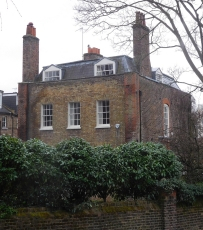
The house was built for the successful upholsterer Thomas Gardnor (c1685-1775) opposite the stocks that were used for punishment until 1831 (Barratt, T: “The Annals of Hampstead). He and his family were responsible for the development of several streets and buildings in Hampstead (www.british-history.ac.uk/vch/middx/v...). Thomas was responsible for building terraces of houses in Flask Walk and homes in what is now Gardnor’s Place. His family also:
“…enlarged their property holdings in the area to include Flask Walk, Streatley Place and parts of Heath Street, High Street and New End. The family also owned houses in Church Row on the site of Gardnor Mansions.” (https://en.wikipedia.org/wiki/Thomas_Gardnor).
In addition to his property interests, Thomas was made a trustee of the Hampstead Wells Charity, which aided the local poor, in 1761 (Barratt, T). Gardnor is believed to have died of smallpox (https://historicengland.org.uk/listing/the-list/list-entry/1067366) and was buried in the graveyard of Hampstead Parish Church, where his tomb may still be seen.
During the mid-19th century, Gardnor House was owned by a dealer in chinaware. Later that century, by which time most of the area around Flask Walk was inhabited by poor people, the grand Gardnor House was the home of an architect. Moving forward 100 years, we find that Gardnor House was the home of the authors Kingsley Amis (1922-1995) and Elizabeth Jane Howard (1923-2014). By the time they moved in, their marriage was crumbling as Joseph Conolly, owner of the former Flask Bookshop in Flask Walk, recalled (https://thecritic.co.uk/issues/november-2020/very-amis-very-hampstead/):
“…by the time they were settled in Gardnor House in Flask Walk — also Georgian, though rather smaller and with a modest garden — the gilt was beginning to chip away from the golden couple, and that deterioration was about to accelerate rather rapidly.”
When they separated, the house was sold in 1981. On the 14th of October 2020, the house, which contains five bedrooms, five reception rooms, and four bathrooms, was sold for £11,000,000 (www.rightmove.co.uk/house-prices/detailMatching.html?prop=66871156&sale=11118685&country=england). GW Potter, a local historian, also once lived in Gardnor House, but I do not know when that was.
The house that Thomas Gardnor built for himself is one of the larger residences within the bounds of old Hampstead. It is either evidence of his success as an upholsterer and/or as a property developer. Luckily, the house seems to be well-maintained. Many of us, who spent our childhood in or near Hampstead, bemoan it having become a more upmarket area than it used to be, but with its property values rising, the condition of many historic buildings is being well-maintained.
March 6, 2021
Accidentally killed
BROMPTON CEMETERY IS in west London. Richly populated with memorials to the dead, it is a remarkably lively place on a sunny day, being filled with walkers, cyclists, and picnickers. The bodies of people from all walks of life and from many nations lie at rest beneath the many stones in the cemetery, which was first opened in 1840. During our recent visit, I spotted two memorials to men with a military career. Each of them was particularly eye-catching.
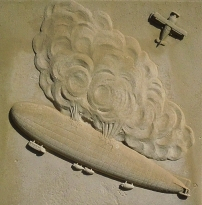
The first of these is a pink granite slab resting on stone cannon balls made of grey granite. A pile of similar canon balls is arranged like a pyramid on top of the stone. I felt that it is a particularly fitting design for a soldier’s gravestone. One of the cannon balls is carved with the word ‘BEYROUT’ and another with ‘PORTUGAL’. This is the memorial to General Alexander Anderson (1807-1877), of the Royal Marine Light Infantry. The monument was restored in about 2016. A document relating to its restoration (https://www.rbkc.gov.uk/idoxWAM/doc/Other-1833173.pdf?extension=.pdf&id=1833173&location=Volume2&contentType=application/pdf&pageCount=1) informs that three of the cannon balls are engraved “Syria”, “Beyrout” (i.e. Beirut), and “Gaze” (i.e. Gaza). However, I photographed one bearing the word “Portugal”, which is not mentioned in the document. The monument was erected by Anderson’s friend Richard Eustace, MD, who lived from 1833 to 1908 (www.bmj.com/content/2/2490/865.2). Eustace entered the Royal Navy as a surgeon in 1854.
Anderson became a Companion of the Order of the Bath in June 1869 (www.thegazette.co.uk/London/issue/23503/page/3179/data.pdf). His obituary in the London “Morning Post”, which shows why he was awarded this high honour, includes mention of Portugal:
“He obtained his first commission as second lieutenant in the Royal Marine Forces in May, 1823, and had during half a century seen much active service. He served with the army of occupation in Portugal, and was for some time quartered at Fort St. Julian. He served at the battle of Navarino in 1827, and at the commencement of the action boarded with his men one of the Turkish ships and captured the flag. … He served throughout the campaign on the coast of Syria in 1840-41 … was at the attack and capture of Beyrout; the bombardment and surrender of St. Jean d’Acre; the surrender of Jaffa, and was a volunteer in the expedition against Gaza. … He had received the war medal with two clasps, also the Turkish silver medal from the Sultan, and when a colonel, received the good-service pension. He became colonel-commandant in November, 1859; major-general in March, I860; lieutenant-general in November, 1866 ; and general in April, 1870.” (www.newspapers.com/newspage/396245337/)
A memorial, less original in design than that of Anderson, also caught my attention with its bas-relief depicting an old-fashioned biplane heading away from a large flying zeppelin from which clouds of smoke are billowing. The grave marks the resting place of Flight-Sub-Lieutenant Reginald Alexander John Warneford (1891-1915). The stone bears the words:
“Accidentally killed 17 June 1915”
Given the year he died and his rank, it was hard to imagine what kind of accident caused him to die during a war when most fatalities were not described as ‘accidents’.
Warneford was born in Darjeeling (India), son of an engineer working for the railways in British India (https://en.wikipedia.org/wiki/Reginald_Warneford). He was educated first in England and then in Simla, back in India. His father:
“…taught him the law of the jungle; to read the moon and stars across the wide Indian night skies; to be able to study cloud formations. Rex rode on the footplates of the service engines, rode the work elephants and hunted tigers.” (http://kes1914.net/the-boys/reginald-rex-warneford-vc/ – a highly informative web page)
At the outbreak of WW1, he joined the British Army and then was soon transferred to the Royal Naval Air Service to be trained as a pilot. He was a good student even if somewhat overconfident. Soon, he became involved in hunting down and intercepting German Zeppelin airships that were being sent to attack London and other targets in the UK.
On Sunday, the 6th of June 1915, Warneford was sent in a Morane Saulnier L monoplane to intercept the heavily armed and well-powered LZ37, a 521-foot-long German zeppelin, which had just taken off from Belgium and had got lost in the fog over the English Channel. German radio signals, intercepted by the British, discovered that the airship had been ordered to return to base. Warneford was sent out to find and attack it. He reached the airship when it was 10,000 feet over Bruges. Warneford rose to 11,000 feet and dropped six bombs onto the Zeppelin, which burst into flames. The hot air from the explosion caused Warneford’s ‘plane to go into a spin and damaged its fuel line. Warneford managed to land in a field behind enemy lines. After rapidly repairing the damage, he managed to fly back to safety, not before landing to refuel at a French base en-route. On the 8th of June, he was awarded the prestigious Victoria Cross for gallantry. Just before that, he was also awarded:
“Chevalier de la Legion D’Honneur with its automatic companion, the Croix de Guerre’ that had been recommended by General Joffre.” (http://kes1914.net/the-boys/reginald-rex-warneford-vc/).
Modestly, he told a friend that in comparison to his grandfather, who had constructed railways in India:
“Bringing down the LZ37 was just routine and over in a flash. But building a railway, that was something.”
Returning to duty after his heroic activity, Warneford’s next mission was to take a new Henry Farman F27 biplane on a test flight. He took off from Paris on the 17th of June 1915 with an American reporter as a passenger. At 2000 feet, the aircraft began to disintegrate and fall downwards. It turned upside down at 700 feet and both pilot and passenger, who were not strapped in, fell to the ground. The reporter died instantly but Warneford survived. However, he died on his way to a hospital.
Had Warneford died whilst attacking a Zeppelin or during any other military encounter, his death would not have been regarded as accidental. As his death was a consequence of an unforeseen disaster, I suppose that calling it an accident is appropriate.
These graves I have described are two of many I saw that attracted my attention. I might well describe some of the others at a later date.
March 5, 2021
Hotel Oslo
A BAR OF SOAP reminded me of our first visit to Portugal. I am looking at a small, round piece of soap sealed in a transparent package labelled “Hotel Oslo”, which we would never have acquired had I not been a victim of pick pocketers on a tram in Lisbon. We had only been in Portugal for about four hours when we took a ride on a picturesque old-fashioned tram (route 28) in the Portuguese capital. I was on the point of taking a picture of a sign that told passengers to beware of pick pocket thieves when I became one of their victims. Amongst the valuables that were stolen from me was my driving licence.
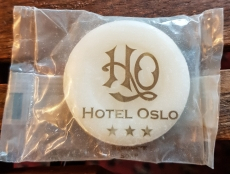
Losing the licence was a disaster as we were planning to hire a car to visit several country places in Portugal. Without the licence, the car hire company was unwilling and unable to lend me a vehicle, but it was good about refunding the money we had paid. We decided that we would attempt to carry out our plans using public transport.
The first place on our itinerary was to have been a farmhouse in small rural place, whose name I do not remember, east of Coimbra. We travelled by train from Lisbon to Coimbra, which has two railway stations in the centre of the city. We discovered that there was a railway line from Coimbra to a spot near our planned destination. When I say “near”, it was really about half an hour’s taxi drive from where we were to stay. After lugging our baggage through the rain about 1000 yards from the station, where the Lisbon train arrived, to the other station from which we were about to depart, we ‘phoned the accommodation to which we were heading. They told us that they did not provide food, not even breakfast, and that the nearest restaurant was about half an hour’s drive from them. As we had no car and were planning to spend three days there, we began to worry how we would survive so far away from any supply of food.
Our next train was not due to depart for another two hours. I decided to walk back to the centre of Coimbra to see whether there was a hotel where we could stay instead of heading out into the ‘wild’. I rushed through the rain and found the Hotel Oslo, which had space for us and did not seem unreasonably priced. After reserving a room, I dashed back through the rain to the rest of the family, who were waiting on the platform. These were the days before we had more than one mobile ‘phone in the family, so I had to reach them to tell them about the Oslo instead of phoning them. Using our one ‘phone, we rang the rural accommodation and explained our plight. They were helpful in that they cancelled our booking gracefully and without cost.
Although not a de-luxe hotel, the Hotel Oslo was solidly built and extremely comfortable. It was located close to most of the sights in Coimbra, a place that had not been on our original itinerary. We spent four pleasant days in this delightful university city, and we were fortunate that, by chance, we were in the city at the time when the university students were starting a new academic year. By day and by night, we encountered groups of boisterous, happy students wandering about the city dressed in traditional capes.
Had my driving licence not been stolen, I know that we would never have stayed in Coimbra and that we would have missed seeing one of the loveliest places that we have so far visited in Portugal. As people say, every cloud has a silver lining. Although I was deprived of a lot of cash, I gained the pleasure of spending time in a wonderful place and witnessing some age-old traditions that added to our fondness of a country that we have grown to love.
The Hotel Oslo was, when we visited it, an old-fashioned style of hotel even though the 20th century building that housed it did not look archaic. Some years after staying there, we spent a couple of nights in the Hotel Mandovi in Panjim, Goa (India). This hotel had been built in 1952 by the Portuguese while they ruled Goa as a colony. It was built to coincide with the Pope’s visit to the Tenth Exposition of the relics of St Francis Xavier, which are kept in Goa. They are ceremoniously displayed once every ten years, subject to the discretion of the authorities who keep them in the Basilica of Bom Jesus in Old Goa. Although the Mandovi looks much older than the Oslo, they both have high standards of service and comfort that are old-fashioned in the best sense of the term. I am not sure whether we have kept any soap from the Mandovi as a souvenir, but you never know, one day we might find we have one lurking about somewhere in our home.
March 4, 2021
Hidden in Hyde Park
WE OFTEN CIRCUMNAVIGATE the Serpentine. Usually, when we stroll around this large body of water shared between London’s Hyde Park and Kensington Gardens, we tend to look mainly towards the water with its busy groups of waterfowl, rather than inland away from the water. Today, in the last week of February 2021, we walked around the Serpentine yet again but this time as we rounded its westernmost end and began heading back along the northern shore, we noticed for the first time a clump of trees within which there is a group of buildings.
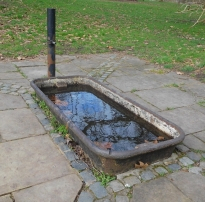 Sheep trough in Hyde Park
Sheep trough in Hyde ParkA wide path leads north from the water towards these buildings, first passing the small single storey Serpentine Lodge, which being close to the lakeshore footpath, I had noticed many times before. It was built in 1839 and was home to various officials connected with the park including the Head Park Constable Joseph Smith (1811-late 1880s), who was living there by 1871 and remained there until his death (https://ifthosewallscouldtalk.wordpress.com/2016/05/31/hidden-histories-serpentine-lodge-hyde-park-london/). The lodge is now a private residence.
Moving inland past the lodge, we soon reach an elegant brick-built two storey house with a triple bay on each side of the centrally located front door. This is the Ranger’s Lodge, which was built in 1831/2. It houses the park’s administrative offices. Attractive because of its age and lovely setting, it is not distinguished architecturally. It stands next to a newer and far more elegant building, The Old Police Station. When I saw the chimney stacks which are built with layers of brick alternating with layers of white stone and the windows framed with white masonry, I was immediately reminded of the former police station and courthouse that stands on Rosslyn Hill in Hampstead. Both police stations, the one in the park (built 1900-02) and that in Hampstead (1912), were designed by the same architect, John Dixon Butler (1860-1920), who designed almost 200 police stations. Two police officers on horses told us that in the yard behind the station, there are stables for the horses of the Park Police. The police station bears a memorial to Jack William Avery (1911-1940), a war reserve Metropolitan Police Constable, who was murdered near the station on the 5th of July 1940. He was stabbed to death by a homeless labourer named Frank Cobbett (https://en.wikipedia.org/wiki/Death_of_Jack_Avery). It was only in 2007 that the memorial plaque was placed in the park.
New Lodge, a large Victorian villa with at least three storeys, built in 1876, now a private residence, stands a few yards north of the police station. This lodge as well as others in the park, like Serpentine Lodge, can be leased from the Royal Parks as dwellings by private individuals and their families. A footpath leads northwest from between the police station and New Lodge and soon passes a disused water pump enclosed within a square area delineated by iron railings. A few feet north of the pump, there is what looks like a large bath next to a vertical pipe that might have once provided water. The map of the park describes these two items as “old sheep trough and water pump”. The bath-like object was the trough and is marked as such on a detailed map surveyed in 1862-6. This map also marks a small “fire engine house”, which no longer exists.
Another structure that no longer stands is a few yards west of Serpentine Lodge. It is commemorated by a stone lying in the grass. The stone bears an inscription that says that it marks the spot where there once stood the ‘Receiving House of the Royal Humane Society’. It had been erected on land granted by The Crown in 1774 and was severely damaged by a bomb during WW2. Its story and that of other receiving houses is related in an interesting article I found on the Internet (https://ifthosewallscouldtalk.wordpress.com/2016/05/31/hidden-histories-serpentine-lodge-hyde-park-london/):
“In 1774 two London doctors, William Hawes and Thomas Cogan, formed the ‘Society for the Recovery of Persons Apparently Drowned’ which later grew into The Royal Humane Society. The society was founded based on the doctors’ fears that people could be mistakenly taken for dead and thereby accidentally buried alive.
To combat this, a number of Receiving Houses were built along waterways in Westminster in the early nineteenth century. The Receiving Houses were designed as places where people could be taken into if they had gotten into difficulty in the water. A Receiving House was built in 1794 on the edge of the Serpentine…”
Judging by what is marked on a detailed map surveyed in 1914, the receiving house covered a considerably larger area than its neighbour, Serpentine Lodge.
Near to the marker for the former receiving house, there is an ugly black metal drinking fountain, marked on the park map as “Lutyens drinking fountain”. This was one of several similar fountains designed in 1950 by “Messrs Lutyens & Greenwood” (http://mdfcta.co.uk/fountains_lutyens.html). As the architect of New Delhi and Hampstead Garden Suburb, Edwin Lutyens, died in 1944, I imagine that the Lutyens who designed this ugly object might well have been his son Robert Lutyens (1901-1972), who published a book with his co-author Harold Greenwood in 1948.
The ugly drinking fountain no longer works. So, if you are thirsty having searched the hidden items that were new to us as described above, help is at hand a little further west, where there is an attractive modern wood-clad café kiosk, one of several of these designed trecently by the Mizzi Studio’s architects (www.floornature.com/).
March 3, 2021
Marx and Mozart … in Soho
‘SEEDY’ IS A WORD that often springs to mind when the London district of Soho is mentioned. Yet, I was unaware of this when I used to visit the area with my mother during the early 1960s. In those days, she was working in the sculpture studios of the St Martins School of Art, which were then located in nearby Charing Cross Road. My mother, a disciple of the cookery writer Elizabeth David, who helped introduce the Mediterranean cuisine into British kitchens, did much of her food shopping in Soho’s Old Compton Street and Brewer Street. It was with these shops, rather than with ‘adult entertainment’, that I associated the district called ‘Soho’.
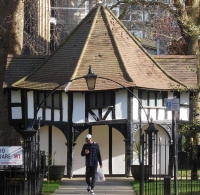
Soho Square, which contains a statue of King Charles II (reigned 1660-1685) that stands in front of a half-timbered structure, was laid out in 1681 during the King’s reign. The area around it had acquired the name ‘Soho’ by 1632. Until the streets in Soho began being developed in the late 17th century, Soho was mostly open fields. Both the gentry and working people began living in the houses built in the area. From the very start of its development, the area attracted refugees from continental Europe:
“The first were Greeks escaping the Ottoman invasion of their homeland in the 1670s. Led by their priest Joseph Georgirenes, they began building a chapel from 1677 in Hog Lane. … It continues to be remembered in the name of Greek Street which ran behind the chapel.
The next group of refugees were Huguenots from France who arrived in the district … By 1711 the population of the parish of St.Anne’s, covering the Soho area, was slightly over eight thousand, of which between a quarter and a half were French. The strong cosmopolitan nature of the area continued well into the 19th century.” (https://www.thehistoryoflondon.co.uk/the-development-of-soho/2/.)
The area continues to be cosmopolitan, as has much of the rest of London now become.
From about 1780 until the 1980s, Soho was the heart of London’s ‘sex industry’. The district’s first brothel opened in 1778 (https://en.wikipedia.org/wiki/Soho_walk-up). From then onwards, the profession of prostitution flourished in Soho. In recent years, the police have been closing some of the places that offered the services of prostitutes. Despite this decrease in the ‘industry’, there is still no shortage of shops selling ‘ adult goods’ related to sexual pursuits in Soho.
Frith Street and Dean Street, two roads that connect Soho Square with Old Compton Street, one of Soho’s main thoroughfares, have had several famous residents. Before you ask, I have no idea whether any of them ever visited any of their neighbours who offered sexual services professionally.
The health care reformer Dr Joseph Rogers (1821-1889) lived and worked at 33 Dean Street from 1851 to 1885. He was living in Soho during the outbreak of cholera in 1854, which led to the ground-breaking epidemiological discoveries of Dr John Snow, who established that cholera was spread through infected water. Rogers helped with the local parish’s response to the disease. When Dr Rogers moved into Dean Street, so also did the better-known, indeed world famous, father of Communism as we know it, Karl Marx (1818-1883), who resided in the street until 1856.
Karl Marx lived above what is now the Quo Vadis restaurant (founded in 1926 by the Italian Peppino Leoni). I am certain that my parents must have eaten there at least once because every year they received a Christmas card from the restaurant. Marx, who arrived in London in 1849, worked on the first volume of his “Das Kapital” whilst living in Soho. His accommodation there was far from comfortable. At first, he:
“… had only two rooms on the second floor of the house – a bedroom at the back used by the whole family and a front room which served as a kitchen and living room – but he later rented a third room for use as a study. The whole ensemble was described by Jenny Marx as ‘the evil frightful rooms which encompassed all our joy and all our pain’.” (www.english-heritage.org.uk/visit/blue-plaques/karl-marx/)
I wonder if members of the Marx family crossed the road to buy goods at the shop with a rococo shopfront (constructed 1791: http://www.british-history.ac.uk/survey-london/vols33-4/pp128-141#h3-0025). Currently, it bears the name ‘Rippon’, and is now a stationer and newsagent.
Carlile Street links Dean Street to Soho Square. The Toucan is a bar that celebrates the association of the drink known as ‘Guinness’ with the toucan. It was the writer Dorothy L Sayers (1893-1957), who when working with SH Benson, an advertising agency, dreamt up the use of the toucan to promote the drink. She composed the following lines in 1946:
“If he can say as you can
‘Guinness is good for you’
How grand to be a Toucan
Just think what Toucan do.” (https://historyhouse.co.uk/articles/guinness_toucan.html)
The half-timbered octagonal hut in the middle of Soho Square looks as if it has been there since the late 17th century. At least, that is what I believed until I began writing this today. Described by the architectural historian Nikolaus Pevsner as “… a silly half-timbered summer house …”, it dates from 1875-76 and was probably built by SJ Thacker.
Frith Street, parallel to Dean Street, leads south from the square to Old Compton Street. One of my favourite writers, the essayist William Hazlitt (1778-1830) died at number 6 Frith Street, now a hotel, which was built in about 1718. Hazlitt moved into two rooms on the second floor at the back of the house early in January1830 (see “The Quarrel of the Age: The Life and Times of William Hazlitt”, by AC Grayling). After a brief incarceration in connection with a debt, he returned to Frith Street, where, by now he was suffering from a stomach disorder that was progressing from bad to worse. It was here in Soho that he wrote one of his last pieces “Emancipation of the Jews”, which argued that restrictions and civil disabilities should be lifted from the Jews. This piece was published after his death in mid-September 1830. Hazlitt was buried in the nearby churchyard of St Anne’s. In his essay, he wrote:
“The emancipation of the Jews is but a natural step in the progress of civilisation … We and modern Europe derived from them the whole germ of our civilisation, our ideas on the unity of the Deity, on marriage, on morals. . . The great founder of the Christian religion was himself born among that people, and if the Jewish Nation are still to be branded with his death, it might be asked on what principle of justice ought we to punish men for crimes committed by their co-religionist near two thousand years ago?” (www.victorianweb.org/religion/judaism/gossman10.html).
Further south along Frith Street, we reach the stage entrance of the London Casino theatre (opened in 1930, with its main entrance on Old Compton Street). There is a commemorative plaque above the stage door, which reads:
“In a house on this site, in 1764-5 Wolfgang Amadeus Mozart 1756-1791 lived, played, and composed.”
The young Wolfgang stayed here with his father Leopold and his sister Nannerl. They were lodgers of Thomas Williamson, who made corsets. They had moved to Soho from Ebury Street near Victoria. It is possible that the composer Johann Christian Bach (1735-1782), son of Johann Sebastian Bach, visited the Mozarts whilst they were living in Frith Street. Wolfgang composed several works in London including his First Symphony, which was premiered in London (https://blogs.bl.uk/music/2018/05/mozartinlondon.html). While this was written at bury Street, the Mozarts held concerts, for which the public were charged, at Williamson’s house in Frith Street.
They lived in a time when all entertainment was ‘live’ rather than recorded or transmitted from one location to another. I feel sure that the greatly inventive Wolfgang Amadeus Mozart would have embraced the performance and publicity possibilities of television with great gusto. Back in Dean Street, a few yards from the Mozart’s Soho lodgings, we find the Bar Italia, currently closed. When it is open, it is usually full of mainly Italians watching matches between Italian football teams on a huge TV screen at the back of the café. This seems particularly apt because the Bar Italia is located on the ground floor of the building where John Logie Baird (1888-1946) gave the first public demonstration of his invention, television, in 1926.
As the Bar Italia is currently closed and you will probably be in need of a good coffee after absorbing so much history in such a small part of Soho, head into Old Compton Street and make a beeline for The Algerian Coffee Stores, where you can buy a brilliant inexpensive espresso, macchiato, cortado, cappuccino, or whatever you want.
March 2, 2021
Coffee al fresco
THE COVID19 PANDEMIC has, for the time being, made drinking inside cafés a thing of the past. If you wish to enjoy a beverage, be it a cappuccino, cortado, americano, a hot chocolate, or even a humble cup of tea, you can buy it at a counter and then enjoy it outdoors, come rain, snow, or shine. In the absence of restaurants and pubs, with the exception of take-away foods, this has become one of the few little treats, apart from the joys of nature, available to those who wish to enjoy a bit of life out in the open air.
Not long ago, whilst exercising in London’s Hampstead district, we came across a particularly lovely place to obtain hot drinks and a selection of snacks, both sweet and savoury. They are being served under a canopy illuminated by strings of ‘fairy lights’ on a terrace overlooking the sloping garden of Burgh House.
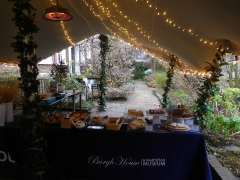
Built in 1704 during the reign of Queen Anne, Burgh House was, according to the historian of Hampstead, Thomas Barratt, first owned by a Quaker couple, Henry and Hannah Sewell. Barratt remarked:
“…the house gives the idea of Quaker severity of style combined with a good quality of work.”
The house acquired its present name in 1822, when it was the residence of the Reverend Allatson Burgh (1769-1856), who was for a time vicar of St Lawrence Jewry (http://www.burghhouse.org.uk/about-us/history-of-the-residents-of-burgh-house#revburgh). He was also the author of a book about church music. Prior to the cleric, the house was occupied, between 1776 and 1820, by the upholsterer Israel Lewis (1748-1820) and his wife Sarah, both known for their good deeds. Lewis was a supporter of the non-Conformist Rosslyn Hill Chapel in Hampstead. The family also provided assistance to the poet John Keats (1795-1821) and his brothers. On the 16th of October 1818, the poet wrote to his brother, who was living in the USA, George Keats (1797-1841):
“Mr Lewis has been very kind to Tom all the summer. There has scarce a day passed but he has visited him, and not one day without bringing him or sending some fruit of the nicest kind.” (“The Letters of John Keats: Volume 1, 1814-1818”)
Burgh House is close to the former chalybeate wells of Hampstead, which were famed for their alleged curative properties. Before the Lewis’s lived there, it was the home of the chief physician of the Wells and a promoter of the benefits of its water, Dr William Gibbons (1649-1728) and his wife Elizabeth. They lived in the house between 1720 and 1743, Elizabeth continuing to live there as a widow.
After Burgh’s death in 1856, the house named after him became the officers’ mess and headquarters of the Royal East Middlesex Militia between 1858 and 1881. The house was then privately owned by several other people, the last of whom were Captain George Louis St Clair Bambridge (1892-1943) and his wife Elsie (1896-1976). Mrs Bambridge’s father was the writer Rudyard Kipling, who was born in Bombay (India). The Bambridges lived at Burgh House between 1933 and 1937. During that time, the ageing Rudyard was a regular visitor.
After the Bambridges left Burgh House for Wimpole Hall in Cambridgeshire, the venerable building faced dilapidation until it was taken over by Hampstead Borough Council in 1946. It was then used for social functions such as wedding receptions.
After a long campaign and much fund-raising, the house was opened to the public as a museum in 2006. In addition to displaying items of historical interest, concerts, talks, and other cultural events are also held there. The concerts are held in a music room that the Reverend Burgh added on to the building when he occupied it. All these life-enhancing activities have come to a halt during the covid19 pandemic. The pleasant and attractive outdoor café is helping to keep the community spirit alive until rates of infection decrease sufficiently to allow at least some return of the cultural activities that we used to enjoy.
The Burgh House café is open from Wednesday to Sunday. Should you visit Hampstead when the café at this place is closed, there are another three Hampstead places, from which we enjoy collecting hot beverages:
Ginger and White in Perrins Court
The Coffee Cup in Hampstead High Street
Matchbox Café in South End Green
There are also a couple of telephone kiosks that have been converted to tiny cafés both in Hampstead High Street and Pond Square, but we have never sampled their wares.
March 1, 2021
Now you see it, now you don’t and Samuel Johnson
THE GROUNDS OF KENWOOD House in north London are delightful at any time of the year. Here you can enjoy the marvels of a fine country house in magnificently landscaped grounds, rivalling rural spots like, for example, Stourhead, Blenhheim, and Compton Verney, without leaving the metropolis. Amongst Kenwood’s many horticultural attractions are the superb flowering bushes such as camellias, azaleas, and rhododendrons.
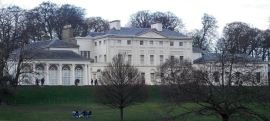 Kenwood House
Kenwood HouseKenwood was within about half an hour’s brisk walk from my family home in Hampstead Garden Suburb and even nearer Highgate School, which I attended between 1965 and 1970. In amongst the flowering bushes, I remember that there used to be an open-fronted, small round hut with a conical roof. Inside it, there were benches that served as seats. This edifice was labelled ‘Dr Johnson’s Summerhouse’. The Dr Johnson to which this referred was one of Britain’s greatest literary figures, the writer and lexicographer Samuel Johnson (1709-1784). When I used to see this hut during visits to Kenwood in the late 1960s and the 1970s, I used to try to imagine the great Johnson sitting, resting and enjoying the view of the lawns and trees, some of which we can still see today. But, in those days, I was unaware that he never did enjoy these views from this spot.
It turns out that Dr Johnson used his summerhouse not in Kenwood but far away at Streatham Place in what used to be countryside south of London during Johnson’s lifetime. Shaun Traynor wrote:
“Streatham Place, the grand country house of the brewer Henry Thrale and his wife Hester, became for a time in the mid to late 18th century a setting for some very distinguished literary and artistic company. To this house, then sitting amid extensive grounds in the countryside south of London, came leading figures of the day: Edmund Burke, David Garrick, Sir Joshua Reynolds (who was to paint the Thrales), Oliver Goldsmith and – most significantly – Dr Johnson.” (https://www.johnsonsocietyoflondon.org/resources/Documents/Dr%20J’s%20Summerhouse%20-%20Shaun%20Traynor/Sam%20J%20summerhouse%20Shaun%20Traynor.pdf).
He added that the grounds of Thrale’s home contained a secluded summerhouse in which Johnson used to read and write. When Henry Thrale (born between 1724 and 1730) died in 1781, his widow Hester remarried, and the Streatham Place with its summerhouse were sold. Thrale’s daughter Susannah, who had been fond of Johnson, moved the hut to her home in Knockholt, Kent in 1826. According to Traynor:
“She erected it on rising ground in the very centre of the grove making all paths lead to it, and making the grove a kind of shrine to Dr Johnson’s memory.”
The years passed, and the summerhouse fell into disrepair. In 1962, a local man, who had great feelings for its historical significance, bought it and then presented it to London County Council (‘LCC’) so that it could be displayed to the public. After restoring it, it was placed in Kenwood at the spot where I recall seeing it, in 1968 (http://www.thrale.com/samuel_johnsons_summer_house). Although it is not inconceivable that Johnson might have visited Kenwood, it is not at all likely that he passed much if any of his spare time in a summerhouse in that garden.
In about 2017, after not having visited Kenwood for two or more decades, I paid it a visit. One of the first things I looked for was Dr Johnson’s summerhouse. I knew exactly where to look, but it was no longer there. After peering in amongst the large clumps of bushes in the spot where I remember that it used to stand, I found an octagonal concrete base. I wondered whether the summerhouse had once stood there. On enquiring at the information desk within Kenwood House, I learnt that the base was all that remained of what I had remembered seeing. I was told that the summerhouse had been destroyed by fire. This fire occurred sometime after 1984, probably 1991 (www.moruslondinium.org/research/dr-jo...). I was saddened to learn of this.
However, all is not lost. Alan Byrne, an artist who used to love sitting in the original Johnsonian summerhouse in Kenwood, has created an accurate replica of the refuge that the great writer used to enjoy. Using detailed plans of the original and other records, he produced an accurate reconstruction during the years 1997 to 1999 (https://www.johnsonsocietyoflondon.org/Dr-Johnson-summerhouse-photos-and-narrative). It stands in his garden in Islington.
Even without Dr Johnson’s summerhouse, Kenwood is well-worth visiting. The gardens alone are splendid, but when it is open, Kenwood House is a ‘must-see’. It contains some fine rooms decorated by Dr Johnson’s contemporary, the architect Robert Adam (1728-1792) as well as a collection of fine-art paintings that is, after the National Gallery, one of the best in London. When you feel that you have seen enough of Kenwood, then treat yourself to a stroll through its grounds and the contiguous Hampstead Heath to historic Hampstead, a place which offers a great range of eateries and pubs. And, incidentally, Samuel Johnson was no stranger to the place as the historian Thomas Barratt revealed:
“‘Mrs. Johnson for the sake of the country air,’ writes Boswell, ‘had lodgings at Hampstead, to which Johnson occasionally resorted. ‘For his own part, Johnson would doubtless have preferred Fleet Street; but he was fond of his wife, and felt in duty bound to minister to her pleasures as far as his limited means admitted.”
I can sympathise with Mrs Samuel Johnson. I much prefer Hampstead to Fleet Street, even if the former has less countrified air than it did in the 18th century.



